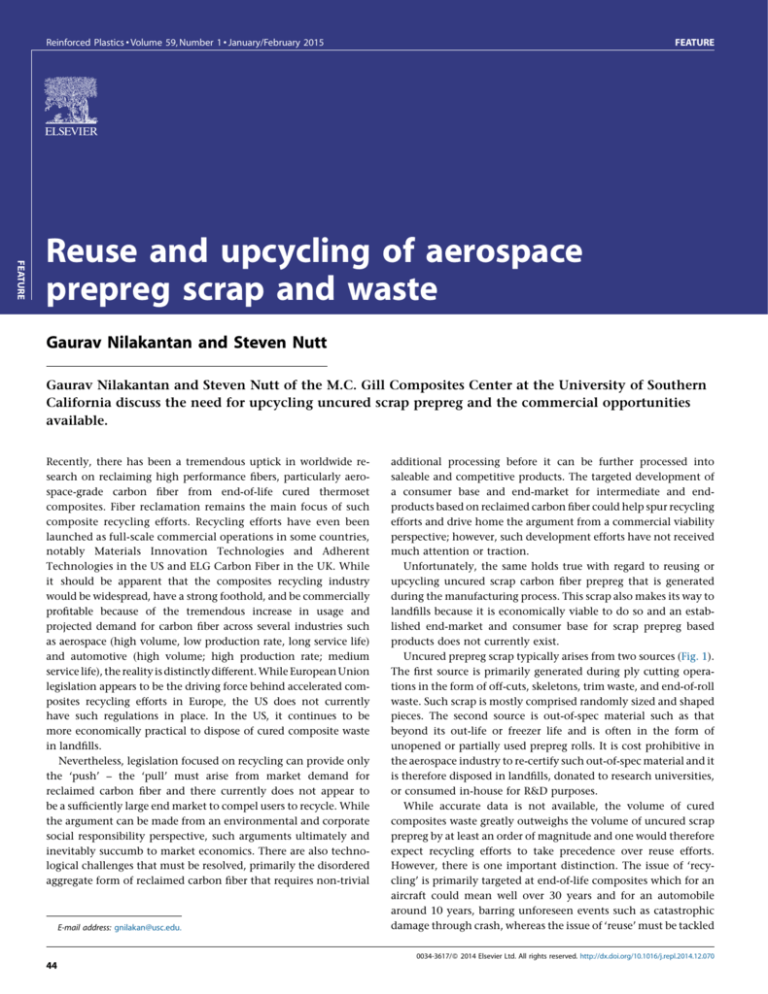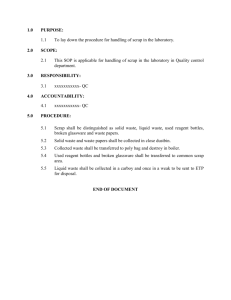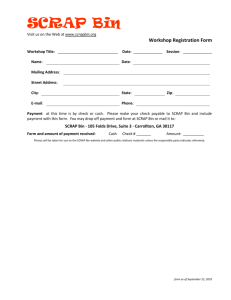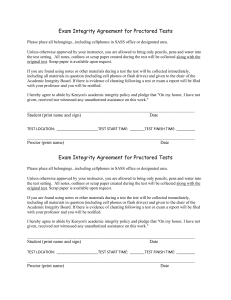
Reinforced Plastics Volume 59, Number 1 January/February 2015
FEATURE
FEATURE
Reuse and upcycling of aerospace
prepreg scrap and waste
Gaurav Nilakantan and Steven Nutt
Gaurav Nilakantan and Steven Nutt of the M.C. Gill Composites Center at the University of Southern
California discuss the need for upcycling uncured scrap prepreg and the commercial opportunities
available.
Recently, there has been a tremendous uptick in worldwide research on reclaiming high performance fibers, particularly aerospace-grade carbon fiber from end-of-life cured thermoset
composites. Fiber reclamation remains the main focus of such
composite recycling efforts. Recycling efforts have even been
launched as full-scale commercial operations in some countries,
notably Materials Innovation Technologies and Adherent
Technologies in the US and ELG Carbon Fiber in the UK. While
it should be apparent that the composites recycling industry
would be widespread, have a strong foothold, and be commercially
profitable because of the tremendous increase in usage and
projected demand for carbon fiber across several industries such
as aerospace (high volume, low production rate, long service life)
and automotive (high volume; high production rate; medium
service life), the reality is distinctly different. While European Union
legislation appears to be the driving force behind accelerated composites recycling efforts in Europe, the US does not currently
have such regulations in place. In the US, it continues to be
more economically practical to dispose of cured composite waste
in landfills.
Nevertheless, legislation focused on recycling can provide only
the ‘push’ – the ‘pull’ must arise from market demand for
reclaimed carbon fiber and there currently does not appear to
be a sufficiently large end market to compel users to recycle. While
the argument can be made from an environmental and corporate
social responsibility perspective, such arguments ultimately and
inevitably succumb to market economics. There are also technological challenges that must be resolved, primarily the disordered
aggregate form of reclaimed carbon fiber that requires non-trivial
E-mail address: gnilakan@usc.edu.
additional processing before it can be further processed into
saleable and competitive products. The targeted development of
a consumer base and end-market for intermediate and endproducts based on reclaimed carbon fiber could help spur recycling
efforts and drive home the argument from a commercial viability
perspective; however, such development efforts have not received
much attention or traction.
Unfortunately, the same holds true with regard to reusing or
upcycling uncured scrap carbon fiber prepreg that is generated
during the manufacturing process. This scrap also makes its way to
landfills because it is economically viable to do so and an established end-market and consumer base for scrap prepreg based
products does not currently exist.
Uncured prepreg scrap typically arises from two sources (Fig. 1).
The first source is primarily generated during ply cutting operations in the form of off-cuts, skeletons, trim waste, and end-of-roll
waste. Such scrap is mostly comprised randomly sized and shaped
pieces. The second source is out-of-spec material such as that
beyond its out-life or freezer life and is often in the form of
unopened or partially used prepreg rolls. It is cost prohibitive in
the aerospace industry to re-certify such out-of-spec material and it
is therefore disposed in landfills, donated to research universities,
or consumed in-house for R&D purposes.
While accurate data is not available, the volume of cured
composites waste greatly outweighs the volume of uncured scrap
prepreg by at least an order of magnitude and one would therefore
expect recycling efforts to take precedence over reuse efforts.
However, there is one important distinction. The issue of ‘recycling’ is primarily targeted at end-of-life composites which for an
aircraft could mean well over 30 years and for an automobile
around 10 years, barring unforeseen events such as catastrophic
damage through crash, whereas the issue of ‘reuse’ must be tackled
0034-3617/ß 2014 Elsevier Ltd. All rights reserved. http://dx.doi.org/10.1016/j.repl.2014.12.070
44
FEATURE
FEATURE
Reinforced Plastics Volume 59, Number 1 January/February 2015
FIGURE 1
Exemplary uncured scrap prepreg – ply cutter scrap and out-timed rolls.
‘here-and-now’ as scrap is continuously generated during the
manufacturing process.
The volume of scrap prepreg is expected to grow rapidly in the
near future because of the huge increase in demand for carbon
fiber prepreg, especially from the aerospace industry with the
introduction of new composites-intensive aircraft such as
the Boeing 787 and Airbus A380 and future models such as
the 777X and A350. According to their respective market outlooks, both Boeing (source: Current Market Outlook 2014–2033)
and Airbus (source: Future Journeys 2013–2032) expect the
world aircraft fleet to double by 2030, with at least 27–34 K
new airplanes valued between US$3.5 and 4 trillion. Note that
uncured scrap prepreg must first be cured before it is disposed
of in landfills because of the potential for toxic chemicals
from the uncured resin to leach into the soil and ground water.
Therefore, the absence of immediate reuse efforts will only serve
to delay the problem and add the volume of uncured scrap
prepreg on to the total volume of cured composite waste that
will eventually need to be recycled. However, there are other
arguments to drive the need for reuse and upcycling efforts, as
described next.
The need for reuse
Reuse efforts are particularly appealing because both the carbon
fiber and resin within the scrap prepreg are usable, high-value
components and do not require destructive separation. The carbon
fiber also continues to remain in its original continuous filament
form whether as a unidirectional tape or woven fabric.
The cost of uncured resin is not inconsequential relative to the
cost of aerospace grade virgin carbon fiber. Consider a generic
aerospace carbon fiber prepreg of 250 g/m2 (1 lb 20 ft2) and cost
$45/lb. Typical ply cutter scrap, depending on the complexity of
the shapes being cut out from the roll and the efficiency of the
nesting routines can range anywhere from 20% to 50%. Considering a conservative 20% scrap rate results in ply cutter scrap of 0.2 lb
(or 4 ft2) per pound of virgin prepreg material, with an associated
original material cost of $9. Typical waste disposal fees can range
from $0.75 to $3 per pound and increases exponentially if the
waste is considered hazardous. Considering waste disposal fees of
$1 per pound results in a total disposal cost of $0.2 per pound of
virgin prepreg material.
Clearly waste disposal fees alone are not going to affect the
bottom line of large companies, although it constitutes a loss of
revenue no matter how small. However, the introduction of
legislation that limits the extent of landfilling and mandates
minimum levels of reuse and recycling, and imposes strict
penalties, fines, and fees for non-compliance can quickly escalate the cost to company associated with waste disposal, thereby
driving the economic argument for reusing or upcycling scrap.
Clearly, considerable savings in material cost can be realized by
45
FEATURE
FEATURE
minimizing the amount of scrap generated in the first place, or
by focusing on ‘reduce’ in the ‘reduce-reuse-recycle’ mantra.
However this may not always be possible.
Continuing with the previous example, obviously the material
cost of the scrap prepreg is no longer $9, because it is no longer in
the form of a continuous prepreg ply but rather an assortment of
scrap pieces of random sizes and shapes or as a cut-out prepreg
skeleton. Thus, there is an apparent material depreciation similar
to the net value of an automobile the moment it is driven off the
dealer lot. If this scrap prepreg is upcycled into commercial endproducts, with value addition occurring at each stage of the
upcycling supply chain through the incorporation of new technology and IP into the intermediate product form and the final
end-product, then the scrap prepreg has some intrinsic value. If
this value (resale rate per pound of scrap prepreg) exceeds current
waste disposal fees, then the economic argument for reuse is
apparent.
This value is what companies can take advantage of to offset
their original material costs, in addition to the amount saved on
waste disposal fees and potential non-compliance fines. Even if a
company were to donate their prepreg scrap to an external
party, there are still considerable savings to be realized. In turn,
this creates an opportunity for new businesses to be created
downstream from the major aerospace and composites industries that consume virgin prepreg, wherein these new entities
consume the scrap prepreg and upcycle it into commercial endproducts. This process may occur entirely within one new entity
that converts the scrap prepreg into a usable intermediate form
and immediately consumes that intermediate form, or as multiple entities. For example, the first entity in the supply chain may
manufacture and distribute the intermediate form while the
second entity consumes that intermediate form and manufactures the end-product. For these downstream entities to be
profitable, value addition must occur at each stage of the upcycling and the margins must be sufficient. For this reason, it is
important to identify high volume applications with appreciable margins over applications such as fillers for concrete
or energy recovery that do not have any appreciable value
addition.
The motive force for the incorporation of new companies to
handle the upcycling of scrap prepreg arises from three assumptions:
(1) that the major players in the aerospace and composites
industries do not want to be distracted from their core
competency;
(2) liability concerns, wherein liability is minimized through the
incorporation of new entities; and
(3) the consumers of virgin prepreg material cannot always
consume their own scrap.
For example, it is not feasible to reuse scrap aerospace prepreg
in primary or critical aerospace structures, as they won’t meet the
performance requirements or pass certification. Their incorporation in secondary or tertiary aerospace structures is as yet
unclear given the potential lack of consistency in the feedstock
material. In such cases, it is far more practical to find a completely different market segment to reuse the scrap aerospace prepreg,
such as for sporting, recreation, and consumer goods. However,
there are exceptions. For example, it is entirely feasible for
46
Reinforced Plastics Volume 59, Number 1 January/February 2015
automotive composite scrap to be reused within the same automobile, and the BMW i3 model showcases one such innovative
example.
There is a general consensus that it is only a matter of time
before the US follows suit and incorporates legislation along the
lines of the European Union that limits the extent of legal
landfilling and mandates levels of reuse and recycling. Therefore,
it may be advantageous for companies to quickly position themselves for looming environmental regulations and to avoid costly
fines and penalties for non-compliance down the road. The lure
of spurring job creation in today’s depressed economy, particularly downstream manufacturing jobs, is another incentive for
companies particularly if it results in additional incentives from
the state and federal government. Finally, many companies want
to be associated with the image of sustainability and being
socially responsible in the public eye, or may want to obtain
certifications such as ISO 14001, which is another reason for
them to support, drive, and incorporate practices such as reduce,
reuse, and recycling.
From scrap prepreg to intermediate product forms
Figure 2 displays the five intermediate product forms that we
envision arising from scrap prepreg, four of which are uncured
and one fully cured form. They are, in order of increasing levels of
additionally required processing:
Resold Prepreg Roll Form (RPRF);
Regular Cutout Form (RCF);
Loose Chip Form (LCF);
Reused Scrap Roll Form (RSRF); and
Composite Construction Material (CCMatTM).
RPRF is comprised unopened or partially opened prepreg
rolls that are no longer within specification. Such material is
typically used for in-house R&D work, donated to research
universities, or sent to landfills. For all practical purposes, RPRF
is equivalent to virgin prepreg; it cannot be used in primary
aircraft structures because it is no longer within the required
specification. RPRF requires little to no additional processing
before sale.
RCF involves identifying scrap pieces that are large enough from
which to cut out regular shaped pieces of prepreg that can be used
as-is in subsequent manufacturing with vacuum bagging, hot
pressing, etc. Figure 2 indicates how such pieces can be cut out
from scrap (see dashed red outlines). RCF can be produced using
standard conveyorized ply cutting equipment in conjunction with
machine vision or simply processed manually. The leftover scrap
pieces at the end of this process can then be converted into LCF.
Higher margins can likely be expected from the sale of the RPRF
and RCF forms as they most preserve the original form of the
prepreg material compared to the other intermediate product
forms described next.
The manufacture of LCF involves mechanically cutting down
the scrap prepreg into rectangular shaped chips. In an automated
process, the cut-outs must move along a conveyor belt through a
two stage cutter, the first stage reducing the scrap pieces into a set
of continuous lineal strips with constant width, with the second
stage cutting the strips into chips of desired length. If the
incoming scrap predominantly consists of extensively cut-out
prepreg skeletons, another option is to use a die press to cut or
FEATURE
FEATURE
Reinforced Plastics Volume 59, Number 1 January/February 2015
FIGURE 2
Intermediate product forms from scrap prepreg.
stamp out the chips in a batch operation model. Manual labor or
machine vision can be used to align the incoming scrap on
the conveyor belt and align one of the fiber directions parallel
to the cutting blades in order to maximize the fiber lengths
in the final chips. While this is not terribly significant for
woven fabric prepregs because of the bi-directional or orthogonal tows, this alignment step is important for unidirectional
scrap prepreg. Also, the backing paper must be removed prior to
cutting, which depending on the nature of the cut-outs, can be
accomplished either manually or via an automated system
comprising of suction cups and pressurized air nozzles to respectively hold the prepreg plies down while blowing off the
backing paper.
Figure 3 displays scrap chips cut from a 5HS woven fabric and a
unidirectional carbon fiber/epoxy prepreg (Cytec CYCOM1 5320)
with the arrows indicating fiber directions.
RSRF is manufactured by compressing LCF at specific temperatures and pressures into a sheet form that is then packaged into a
roll form with a wax backing paper and/or protective film
much like a virgin prepreg roll. The applied temperature is just
sufficient to cause low extents of resin flow required to bond the
chips together, which is especially necessary when they have no
tack. The applied high compaction pressures give RSRF a thin
structure and a smooth surface.
We envision four forms of the RSRF: general purpose roll,
surfacing roll, hybrid roll, and a tooling roll. The general purpose
roll is highly customizable in its composition (e.g. fiber bed
architecture, resin system, chip shape and size) and structure
(e.g. thickness, areal weight, distribution and orientation of chips)
and can be tailored depending on the end application. The hybrid
roll is a sandwich structure comprised the general purpose roll at
its core with skins comprised either regular prepreg rolls (i.e. outof-spec material) or large scrap pieces (e.g. RCF). Using out-of-spec
FIGURE 3
Individual scrap prepreg chips.
47
FEATURE
Reinforced Plastics Volume 59, Number 1 January/February 2015
the limitless potential end-products and applications for scrap
prepreg.
Processing of intermediate scrap-based product forms
FEATURE
FIGURE 4
Cure cycles.
rolls at the surface of the hybrid roll will keep overall material
costs low, provide the same visual appearance and aesthetic that
customers are accustomed to with regular prepreg composites, and
have a cumulative effect on the mechanical performance
(strength/stiffness).
LCF and RSRF are better known as InfinipregTM; a name that
derives from the ‘Infinite possibilities for scrap prepreg’, a reference to
The LCF form resembles a bulk molding compound (BMC) of
which several commercial forms are available from companies
such as TenCate and Hexcel in the form of chopped virgin unidirectional prepreg. LCF can be similarly compression molded into
the final part.
The RSRF form resembles a sheet molding compound (SMC) and
can be processed by all the traditional routes used for virgin
prepreg such as autoclaving, vacuum bagging, hot pressing, and
compression molding. However preferred processing routes for
RSRF are through hot pressing and closed mold compression.
Apart from being simple, rapid, and inexpensive, these two processing routes do not require consumables (sealant tape, breather,
vacuum bags, et cetera) that would add to the overall waste stream.
They also do not require lengthy room temperature vacuum holds
or debulking cycles that add to the overall cycle times. Parts can be
made continuously by placing the two caul/tool plates or closed
mold fixture directly between the preheated platens of a hot press
and removing them at the end of the dwell cycle without waiting
for the part to cool. Another significant advantage of the RSRF
form is the ability to use accelerated cure cycles which reduce the
overall cycle times.
For example, Fig. 4 compares one of the manufacturer’s
recommended cure cycles for the CYCOM1 5320 prepreg system
(1.5 8C/min ramp up, 121 8C dwell) along with the cure cycles we
used when manufacturing 5320 prepreg scrap (5HS and UNI chips)
FIGURE 5
Exemplary manufacturing routes (a) open platen compression, (b) closed mold compression, (c) VBO processing.
48
FIGURE 6
End product space for scrap prepreg.
based laminates in a hot press, where a 135 8C dwell was used along
with ramp up rates as high as 40 8C/min.
Figure 5 shows three potential manufacturing routes with LCF
and RSRF. VBO-processed laminates produced with RSRF yield a
breather-side finish similar to their virgin prepreg counterparts.
The advantage of VBO processing using RSRF is that the part size is
not limited by the size and capacity of the hot press, and a simple
vacuum pump is sufficient to apply the compaction pressure
(14.7 psi) regardless of the part size moreover, while large convection ovens are not cost prohibitive. The part can also be cured
using simple thermal blankets or self-heated tool plates. The
downside of using VBO and the corresponding reduced compaction pressure is that poorer compaction can result at sharp corners
within the part, and in such cases, compression molding is preferable.
Technology demonstrators and end-products
We believe there are potentially hundreds of end-products that
can be built partially or entirely from scrap thermoset prepreg.
Carbon fiber composites are not just used for their lightweight
properties and superior structural performance but also coveted for
FEATURE
their distinctive visual appeal and therefore find dozens of
aesthetic-based applications such as arm rests, cell phone cases,
and cup holders which are non-structural, and customized home
and office furniture which is structural in nature. Parts made from
Infinipreg possess a unique and distinctive look of their own
because of the random placement of chips on the surface that
tends to reflect incident light differently and create a shimmering
effect, which can therefore compete in the aesthetic-based product
market. Preliminary studies have also established the good stiffness and strength retention properties of scrap prepreg chip based
laminates thereby also opening up structural end-products to
Infinipreg.
We believe that scrap prepreg based parts will be competitive for
two reasons:
(1) they can compete with some existing carbon fiber products
because of the lower price points brought to bear by the much
lower starting material costs; and
(2) they can compete with other traditional materials in
applications where carbon fiber was previously discounted
for being cost prohibitive.
Thus, Infinipreg can not only compete with but also open up
new markets to carbon fiber composites. Figure 6 displays some of
the major industries we have identified that would be highly
amenable to scrap prepreg.
In the medical devices field, the radiolucent property of carbon
fiber composites can be exploited to make hospital/ICU beds and
structural casings for medical devices. We have also made a
prosthetic running foot (GazelleTM) out of scrap CF/epoxy prepreg,
Fig. 7a. Potential sporting and recreation goods include skateboards, snowboards, snow-sleds, go-karts, and kayaks. We have
manufactured skateboards using only scrap CF/epoxy prepreg
(Cobra-ZTM) as well as a mix of scrap CF/epoxy and fiberglass/
epoxy prepreg (Crazy ZebraTM), Fig. 7b.
Figure 7c displays several sub-structural or design elements that
can be used in structural applications, such as thin and thick
panels, hat stiffened panels, cylinders, sandwich structures with
a honeycomb or foam core, and veneers. The black/yellow
colored veneer shown in Fig. 7c consists of scrap 5HS CF/epoxy
prepreg chips + dry plain weave Kevlar fabric chips + custom
formulated epoxy, just to illustrate how different fibers, architectures, and resins can be mixed together. Obviously, the use of
scrap prepreg in aerospace and automotive applications must be
restricted to non-critical components such as interiors and
paneling.
We also see a large potential market for rail, truck and sea
intermodal or freight containers and unit load devices used at
airports. The potential weight savings over currently used materials such as weathering steel and aluminum could result in enormous fuel savings when transporting these shipping containers
apart from the other obvious benefits of composite materials, such
as good FST properties and resistance to corrosion and infestation.
We also see applications of Infinipreg in low cost and potentially
self-heated composite tooling for low volume and prototype jobs,
where a skin of Infinipreg is supported by a carbon or polyurethane
foam backing. Consumer and household goods could include cell
phone cases, desktop computer cases, laptop and tablet covers,
award plaques, cup holders, trays, and other such novelty items,
Fig. 7d.
49
FEATURE
Reinforced Plastics Volume 59, Number 1 January/February 2015
FEATURE
Reinforced Plastics Volume 59, Number 1 January/February 2015
FEATURE
FIGURE 7
Scrap prepreg based technology demonstrators and potential end-products, using Infinipreg and CCMat (a) Gazelle prosthetic foot, (b) skateboards,
(c) design elements, (d) novelty items, (e) constructional material.
Finally, the striking similarity between wood chip board and
oriented strand board with scrap chip-based laminates leads to
potential applications for CCMat as a construction material (e.g.
flat stock and prefab), Fig. 7e.
Concluding remarks
Whether driven by government regulations, corporate policy, or
market economics, the 3 Rs of Reduce–Reuse–Recycling represent the
pillars of sustainability in the context of the global composites
50
industry and the environment. Of the three, recycling has
received perhaps the greatest attention both from academia and
industry. However, active efforts to reduce and reuse waste lag
considerably.
With the ever increasing use of carbon fiber prepreg (thermoset)
material across multiple industries, most notably commercial
aerospace, the volume of uncured scrap prepreg will increase
considerably in the future. The lack of any substantive previous
reuse efforts for uncured scrap prepreg spurred us to address this
Reinforced Plastics Volume 59, Number 1 January/February 2015
Further information
Dr. Gaurav Nilakantan is a Senior Research Associate at the University of Southern California (USC) and the Editor-in-Chief of the
Journal of Multifunctional Composites. His broad research inter-
ests include manufacturing, characterization, and large scale FEA
of advanced composites for aerospace and armor applications; email: gnilakan@usc.edu; composites.usc.edu/
Prof. Steven Nutt is the M.C. Gill Professor of Chemical Engineering and Materials Science at USC and the Director of the M.C.
Gill Composites Center. He serves the lead PI of the NSF G8 funded
project. He has authored/co-authored over 200 journal articles and
serves on the editorial board of Composites Part A journal.
Acknowledgements
This work was supported by the National Science Foundation
(NSF) G8 Initiative ‘Material Efficiency: A First Step towards
Sustainable Manufacturing of Composite Materials’ (Award #
CMMI-1229011). Additional support was provided by the M.C.
Gill Composites Center at the University of Southern California.
51
FEATURE
issue directly to demonstrate a potentially cost-effective and feasible solution to responsibly manage the scrap prepreg stream.
Ultimately, it is not just the basic technology ‘push’ that is
important to develop from an early stage, but also the end-market
‘pull’. Our intent through our ongoing work at the University of
Southern California is to steer attention to near-term reuse efforts
on a large scale by demonstrating both the technical and economic feasibility along with several potential end-products. We
anticipate a significant first-mover advantage in this emerging
market.
FEATURE

![You`re invited to celebrate [child`s name]`s birthday at SCRAP! What](http://s3.studylib.net/store/data/007177272_1-c15601fb9e11b26854f13f1982e634e8-300x300.png)






